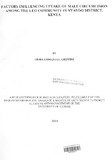| dc.description.abstract | This study discusses the relationship between the human environment and disease prevalence in Seme, Kisumu District, Kenya. The principal objective of the study was to investigate risk factors that influence hookworm transmission among the local population in the rural areas of Seme. The study examined those factors by focusing on the area's environment, people's behaviour and their socioeconomic conditions. However, the study limits itself to identifying those risk factors which favour hookworm transmission. Therefore, this is not a parasitological analysis which is concerned with who is (or is not) infected with hookworm.
The study was guided by the ecological approach with cultural and biological parameters which view the distribution of disease in broad dimensions. Relevant data were collected through various methods, involving both quantitative and qualitative techniques. Direct observation, survey technique, informal interviews and secondary sources were among the methods used. The data collected through the survey technique was analyzed quantitatively while the data from the other sources was summarized and analyzed qualitatively. A total of 98 informants, randomly selected from a population of 3,560 persons, participated in the study.
An analysis of the findings indicates that hookworm transmission in the study area is influenced by environmental and behavioural risk factors as well as socioeconomic conditions of the population. While environmental factors favour hookworm development and survival, behavioural patterns and socioeconomic conditions expose the population to the risk of infection.
The study concludes that the environment, behaviour and socioeconomic conditions are linked to hookworm transmission in the area of study. The prevalence rates as well as intensity levels are likely "to prevail unless the risk factors are addressed. It is recommended that a combination of improved sanitation, mass chemotherapy and health education will help in reducing and, probably, controlling the transmission of hookworm infection in the
area. | en |

